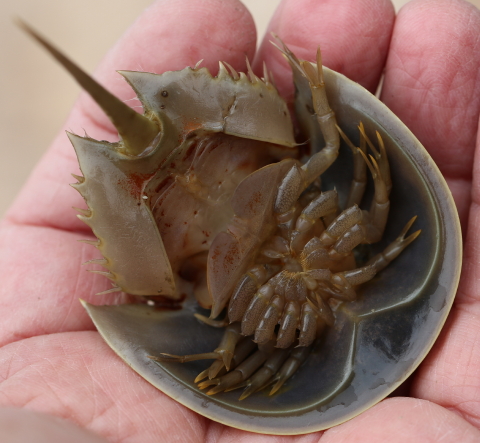Sue Wieber Nourse Examines Two Juvenile Horseshoe Crabs
Juvenile horseshoe crabs rocked Outer Cape salt marsh creeks during the April 28th flood tide. Â Turtle Journal celebrates the emergence of these true “blue bloods” each spring. Â We have been checking for their awakening since late March, but this year’s cold spring temperatures have prolonged their winter slumber. Â (See Salt Marsh Awakening: Juvenile Horseshoe Crabs Active on Outer Cape, April 18th, 2013 and Mid-March Emergence of Juvenile Horseshoe Crabs, March 19th, 2012.)
Two Juvenile Horseshoe Crabs (Limulus polyphemus)
Admittedly, the horseshoe crabs we discovered this morning were a bit sluggish in today’s chilly water temperatures, under cloudy skies and with a stiff northeast ocean breeze. Â Today’s specimens ranged in weight from a little over 1/2 ounce (17 grams) to 4 1/3 ounces (122 grams). Â The horseshoe crab’s exoskeleton (shell) does not expand. Â To grow, horseshoe crabs molt, as many as five times in the first year, three in the second, two in the third, and once a year thereafter until maturity is achieved. Â It takes sixteen and seventeen molts respectively over a period of nine to eleven years for a male and female horseshoe crab to reach maturity.
Tiny 1/2 Ounce Juvenile Horseshoe Crab (Limulus polyphemus)
Ventral View of Juvenile Horseshoe Crab (Limulus polyphemus)
Measuring Tiny Juvenile Horseshoe Crab (Limulus polyphemus)
The tiniest horseshoe crab measured less than 2 1/4 inches (~ 6 centimeters) long (minus its tail/telson). Â As you may know, horseshoe crabs are the true “blue bloods” of the animal kingdom with blood composed of copper rather than iron. Â This limulus blood yields a unique and powerful gram-negative bacterial detector that saves human lives. Â Horseshoe crabs have also been extremely valuable in the research of vision with both compound and simple eyes, as well as facilitating many other scientific and medical breakthroughs.
Larger (4 1/3 Ounce) Juvenile Horseshoe Crab
Ventral View of 4 1/3 Ounce Juvenile Horseshoe Crab
The largest juvenile horseshoe crab we encountered this morning measured about three times the length of the smallest and hit the scales at 4 1/3 ounces.  The ventral (bottom) view of this juvenile horseshoe crab clearly shows the five walking legs on each side, the forward feeding pincers (Chelicerae), and the rear book gills.  The telson (tail spine) is pointed directly at the camera.
Juvenile Horseshoe Crab (Limulus polyphemus)
Juvenile horseshoe crabs are delightful to watch as they plow through the sandy bottom of creek channels. Â As adults, horseshoe crabs are Nature’s auto-tillers, constantly refreshing coastal tidal and inter-tidal flats. Â Appearing as ancient as the earliest trilobites, horseshoe crabs stir awe in the Turtle Journal team. Â Sadly, humans have harvested these valuable critters to the edge of extinction, extirpating them from one estuary after another, impoverishing our entire tidal and inter-tidal eco-systems, and driving shorebirds that survive epic migrations on nourishing horseshoe crab eggs to the brink, as well. Â So, it is especially joyful each spring to find juvenile horseshoe crabs as we continue to hope for sanity to prevail among state and federal wildlife managers of this important foundational marine species.






















